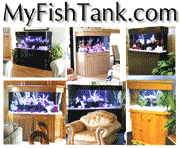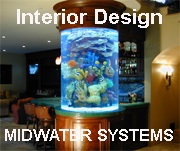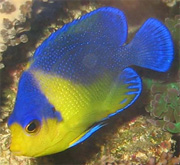|
Lighting, What you need to know.
By Clayton Romie
Too light or not too light…that is the question - or at least
the question on every reefkeepers lips. In the hobby today, lighting is
one of the most controversial subjects. Even the experts disagree. As new
technology advances come to market in the lighting area, we are all struggling
to keep up with the new bulbs, ballasts, dimmers, etc. I have been in the
hobby for 15 years and have tried quite a few different bulbs and lighting
techniques (not to mention spent a lot of dollars.) In this article I am
going to share some of the things that I have picked up over the years.
When you set up a reef tank or you have an existing one and want to
change lighting, there are a few things that you may want to consider.
If this is a new tank, you need to consider what type of tank you want
it to be. For instance, soft corals will do just as well under 40 watt
fluorescent bulbs as under metal halide lights. "SPS" (Small Polyp stoney)
corals on the other hand demand stronger lighting.
Whether you decide to go with fluorescents, metal halide or power compact
fluorescents, first of all make sure you check how many amps your ballast
will run. Four hundred watt ballasts will run at 4 amps, so when you combine
two or three bulbs, with all your pumps and gadgets, you may blow your
circuit breakers.
More times than I can count, I've seen reefkeepers install their tanks,
get them up and running, and turn on the lights and "poof" - the breaker
blows. Often, to make matters worse, the outlet is behind the tank. So,
make sure that you add up the amperage before you install anything. When
you are ready to purchase your ballasts, always ask your dealer to make
sure they are UL listed. UL stands for Underwriters Laboratory and parts
that receive this listing must go through extensive testing before they
receive this label. If it does not say "UL Listed" on the unit, it may
not be completely safe.
Also, it is a good idea to bridge your ballasts across a couple of concrete
block (cinder block) or a couple of bricks. This is a good idea for two
reasons. First, it will raise the ballasts off of the ground or the bottom
of the cabinet. By bridging the ballast on two bricks, you will help airflow
underneath it and help to keep it cool. The second reason is that ballasts
run very hot, depending on the wattage you use, and it is not a good idea
to put the ballasts on flammable material, like carpet or wood or anything
that could cause a fire.
Bulbs: There are many types of bulbs: fluorescent, VHO (Very High Output)
Fluorescent, Power Compact Fluorescent and the many varieties of metal
halide bulbs with Kelvin ratings of 5500, 6500, 10,000, 14,000, 20,000.
The color temperature of the bulb is referenced in degrees Kelvin (K),
with the higher the color temperature, the whiter the bulb. That is because
the violet blue and green parts of the color spectrum prevail. If the color
temperature of the bulb is lower, the warmer the appearance of the light,
with the orange and red hues of the spectrum dominating. One of the main
topics of debate is which Kelvin rating is best for which corals so as
to keep their natural colors.
Most of the corals that are imported today are from waters ranging from
10-20meters deep (33-66 feet). If you have ever gone snorkeling or
scuba diving, or just watched an under water video, you know that at those
depths, the color of the water is blue. The orange and red spectrum is
drastically reduced; thus there are more violet blues and greens at those
depths. Unfortunately, the higher the Kelvin rating of the bulb, the lower
the intensity. So, therefore you will need a higher wattage bulb if you
decide to use a 20,000K-rated bulb.
Every bulb runs differently, even if you compare ones made by the same
manufacturer. Metal halides in particular are prone to large variations
in lux readings, sometimes 1000 more or less difference. Metal halides
bulbs run very hot, so unless you have a chiller or some other way to keep
the water cool I do not recommend using these bulbs. Also, metal halides
are meant to run at room temperature, so if you have fans in your canopy,
especially strong ones (90 cfm or cubic feet per minute or higher), do
not aim them directly at the bulbs. I have done this and found out that
the bulb will run dimmer because it is being cooled too much. Metal halide
bulbs should be changed at least once a year. I personally change them
every six months to drastically reduce the shock of new bulbs on the animals.
When you change bulbs, you should cut your photo period to 3 hours and
build up to your maximum time over a period of 1 1/2 - 2 weeks. If you
do not do this, you will soon find your corals turning white (bleaching).
Fluorescence: Fluorescent bulbs come in different forms for the aquarium
hobby. The standard bulbs come in 15, 20 and 40 watts while VHO bulbs
come in 75, 95, 110, 140 and 165 watts. The compact fluorescent bulbs are
also a high wattage fluorescent. They come in 55 and 96 watt. All of this
type or family of bulbs certainly run more efficiently than metal halide
bulbs (per watt to amp). They will also run cooler than halides. The only
drawback to these bulbs is that they are not as intense as metal halides
and they need to be changed every 6 months (except the compact fluorescence,
which some manufacturers claim will last for 3 years.) Unfortunately, I
have had some of these bulbs and so far they have lasted about one year
to 1 1/2 years. I am in the process of trying new compacts, but they have
only been on the market for about a year, so, we'll see.
Reflectors: It is very important that you use a reflector so you don't
waste all that money you spent on bulbs and ballasts, because if you don't
reflect the light, you will have lost about 1/3 - 1/2 of the bulb's capacity.
There are quite a few reflectors on the market, sold by themselves or in
lighting units. I had asked a friend of mine who is an optical engineer
which surface would reflect best. She said that a mirror is the best reflector
you can use. Unfortunately, because I was using 400-watt bulbs, I could
not use a lightweight plastic mirror because it would have melted. Glass
was just too heavy to install in the canopy, considering the size glass
mirror I would have needed. The next best thing was a polished aluminum
reflector. Today, reflectors come in white, which disperses the light but
also softens it, so you actually lose some of the light. There are the
hammered reflectors that have an inside surface like a bunch of dimples.
The points of light bounce off of the dimples and back into the water.
The end result is an even coverage, but a loss of some of the intensity.
Whichever lighting system you decide to go with, remember to light the
tank according to the type of animals you will be keeping. Why spend the
money on a metal halide system if you are going to keep mushrooms. I hope
this will column will help you with some of your choices, or at least help
a few of you before you whip our your checkbook.
|











